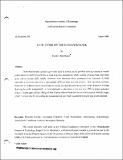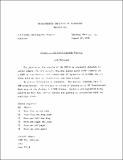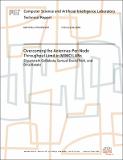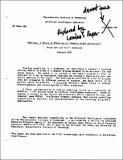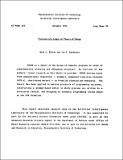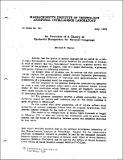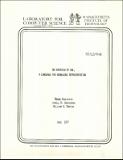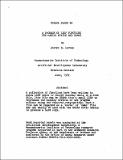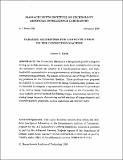Browsing Computer Science and Artificial Intelligence Lab (CSAIL) by Title
Now showing items 2425-2444 of 3804
-
An Outlook on Truth Maintenance
(1980-08-01)Truth maintenance systems have been used in several recent problem solving systems to record justifications for deduced assertions, to track down the assumptions which underlie contradictions when they arise, and to ... -
Output to the PDP-6 Calcomp Plotter
(1966-08-01)The plotter on the console of the PDP-6 is currently attached to device number 774, and accepts stepping pulses given under control of a CONO to that device. Its normal mode of operation is to CONO the desired bits on, ... -
Overcoming the Antennas-Per-Node Throughput Limit in MIMO LANs
(2009-02-18)Today, the number of concurrent packets in a MIMO LAN is limited by the number of antennas on the AP. This paper shows how to overcome this limit. It presents a new design where multiple client-AP pairs can communicate ... -
Overlays: A Theory of Modelling for Computer Aided Instruction
(1977-02-01)Overlay modelling is a technique for describing a student's problem solving skills in terms of modular program designed to be an expert for the given domain. The model is an overlay on the expert program in that it consists ... -
Overview of a Linguistic Theory of Design
(1977-02-01)SPADE is a theory of the design of computer programs in terms of complementary planning and debugging processes. An overview of the authors' recent research on this theory is provided. SPADE borrows tools from ... -
Overview of a Linguistic Theory of Design
(1977-02-01)The SPADE theory uses linguistic formalisms to model the program planning and debugging processes. The theory has been applied to constructing a grammar-based editor in which programs are written in a structured ... -
An Overview of a Theory of Syntactic Recognition for Natural Language
(1979-07-01)Assume that the syntax of natural language can be parsed by a left-to-right deterministic mechanism without facilities for parallelism or backup. It will be shown that this "determinism" hypothesis, explored within the ... -
An Overview of MOOS-IvP and a Brief Users Guide to the IvP Helm Autonomy Software
(2009-06-18)This document describes the IvP Helm - an Open Source behavior-based autonomy application for unmanned vehicles. IvP is short for interval programming - a technique for representing and solving multi-objective optimizations ... -
An Overview of MOOS-IvP and a Users Guide to the IvP Helm - Release 4.2.1
(2011-08-03)This document describes the IvP Helm - an Open Source behavior-based autonomy application for unmanned vehicles. IvP is short for interval programming - a technique for representing and solving multi-objective optimizations ... -
An Overview of MOOS-IvP and a Users Guide to the IvP Helm Autonomy Software
(2010-08-27)This document describes the IvP Helm -- an Open Source behavior-based autonomy application for unmanned vehicles. IvP is short for interval programming -- a technique for representing and solving multi-objective optimizations ... -
An Overview of OWL, A Language for Knowledge Representation
(1977-06)We describe the motivation and overall organization of the OWL language for knowledge representation. OWL consists of a memory of concepts in terms of which all English phrases and all knowledge of an application domain ... -
PAC-Learning Prolog Clauses With or Without Errors
(1994-02)Recently researchers have been interested in trying to expand the domain of learnability to subsets of first-order logic, in particular Prolog programs. This new research area has been named Inductive Logic Programming ... -
A Package of LISP Functions for Making Movies and Demos
(MIT Artificial Intelligence Laboratory, 1972-06)A collection of functions have been written to allow LISP users to record display calls in a disk file. This file can be UREAD into a small LISP to reproduce the display effects of the program without doing the required ... -
Packet Communication
(1973-12)This report develops a theory of packet communication; it analyzes users of computers in digital communication systems and examines structures for organizing computers in highly communicative environments. Various examples ... -
Packet Trains: Measurements and a New Model for Computer Network Traffic
(1985-11)Traffic measurements on a ring local area computer network at Massachusetts Institute of Technology are presented. The analysis of the arrival pattern shows that the arrival processes are neither Poisson nor Compound ... -
PADL - A Packet Architecture Description Language: A Preliminary Reference Manual
(1983-10)PADL is a hardware description language for specifying the behavior and structure of packet communication systems. In such systems, hardware units called modules communicate by sending and receiving packets. The behavior ... -
Paradigms for Structure in an Amorphous Computer
(1997-10-01)Recent developments in microfabrication and nanotechnology will enable the inexpensive manufacturing of massive numbers of tiny computing elements with sensors and actuators. New programming paradigms are required for ... -
Parallel Algorithms for Computer Vision on the Connection Machine
(1986-11-01)The Connection Machine is a fine-grained parallel computer having up to 64K processors. It supports both local communication among the processors, which are situated in a two-dimensional mesh, and high-bandwidth ... -
Parallel and Deterministic Algorithms for MRFs: Surface Reconstruction and Integration
(1989-05-01)In recent years many researchers have investigated the use of Markov random fields (MRFs) for computer vision. The computational complexity of the implementation has been a drawback of MRFs. In this paper we derive ...

